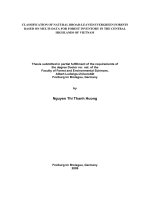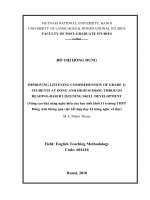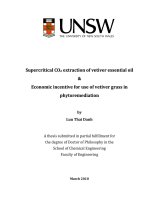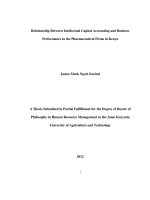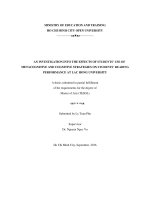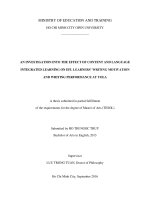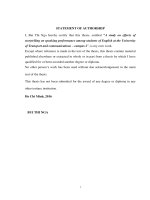Effects of concept maps on reading comprehension of grade ten students at tri duc high school a thesis submitted in partial fulfillment of the requirements for the degree of master of arts
Bạn đang xem bản rút gọn của tài liệu. Xem và tải ngay bản đầy đủ của tài liệu tại đây (5.12 MB, 169 trang )
MINISTRY OF EDUCATION AND TRAINING
HO CHI MINH CITY OPEN UNIVERSITY
------------------------------
EFFECTS OF CONCEPT MAPS
ON READING COMPREHENSION
OF GRADE-TEN STUDENTS AT TRI DUC HIGH SCHOOL
A thesis submitted in partial fulfillment
of the requirements for the degree of
Master of Arts (TESOL)
Submitted by
LE THUY VY
Supervisor
Dr. NGUYEN THUY NGA
Ho Chi Minh City, September 2016
STATEMENT OF AUTHORSHIP
I certify that this thesis entitled, “Effects of Concept Maps on Reading
Comprehension of Grade-Ten Students at Tri Duc High School” is my own work.
Except where reference is made in the text of the thesis, this thesis does not contain
material published elsewhere or extracted in whole or in part from a thesis by which I
have qualified for or been awarded another degree or diploma.
No other person’s work has been used without due acknowledgement in the main text
of the thesis.
This thesis has not been submitted for the award of any degree in any other tertiary
institution.
Ho Chi Minh City, 2016
Le Thuy Vy
i
ACKNOWLEDGEMENTS
My thesis would not be done without any assistance and contributions of many
people. Thus, this is an opportunity for me to express my gratitude to all of them.
First and foremost, I would like to give my deep gratitude to my supervisor –
Dr. Nguyen Thuy Nga, who always helped and spent her limited time reading and
giving advice for my thesis as well as showed me how to do the thesis better.
Secondly, I would like to give my thanks to Ho Chi Minh City Open University
for giving me chance to finish my study to get a Master degree in many different
ways.
Thirdly, to my colleagues in Tri Duc High School, who gave me permission
and chance to complete my thesis within the school year 2015-2016, I appreciated
their contributions and encouragement during the time I did the research.
I am also grateful to some of my friends of TESOL 8. They spared their time to
help me and share their experience in doing the thesis.
Finally, I would like to send my deep love to my family. They always
encouraged me to do well and to keep moving forwards to complete what I had
started. It was they who were with me through difficulties and supported me when I
needed help so that I had enough energy to complete my thesis.
ii
ABSTRACT
English nowadays is considered as an international language that is widely
used around the world. English language skills have become a topic for studied by
many researchers, including reading comprehension. Besides, concept maps are also
believed to help improve students’ reading comprehension. A study was conducted
with two classes of 10 graders in Tri Duc High School in Ho Chi Minh City to
measure the effects of concept maps on students’ reading comprehension in a private
high school setting. The two classes were named control group and experimental
group. They learnt reading with the same approach – Communicative Language
Teaching- but with one difference that is the intervention, i.e. concept maps in the
experimental group. Before that, the students of the two groups took a pretest on
reading comprehension and an independent t-test was used to analyze the results to
ensure the same level of reading comprehension performance of the two groups. After
inconsecutive 5 periods of reading lessons, they took a reading comprehension
posttest. The students of the experimental group were asked to do a questionnaire to
investigate their attitudes towards the use of concept maps on reading comprehension.
The data were collected, coded by computer software and analyzed. The results
revealed a statistically significant difference in the posttest scores of the two groups
after the treatment. Besides, the students of the experimental group appeared to have
better posttest scores than those of the control group. Most of the students of the
experimental group also showed their agreement in the use of concept maps in reading
lesson. Therefore, concept maps had positive effects on Tri Duc grade-ten students’
reading comprehension and most of them showed positive attitudes towards this new
strategy.
iii
TABLE OF CONTENTS
STATEMENT OF AUTHORSHIP ................................................................................. i
ACKNOWLEDGEMENTS ........................................................................................... ii
ABSTRACT ..................................................................................................................iii
TABLE OF CONTENTS .............................................................................................. iv
LIST OF FIGURES ...................................................................................................... vii
LIST OF TABLES.......................................................................................................viii
ABBREVIATIONS ........................................................................................................ x
Chapter 1: INTRODUCTION ........................................................................................ 1
1.1 Background to the study ....................................................................................... 1
1.2 Problem statement ................................................................................................. 3
1.3 Research aims ....................................................................................................... 4
1.4 Research questions ................................................................................................ 5
1.5 Research significance ........................................................................................... 5
1.6 Overview of thesis chapters .................................................................................. 5
Chapter 2: LITERATURE REVIEW ............................................................................. 7
2.1 Theoretical Background to the Research .............................................................. 7
2.1.1 Reading comprehension ................................................................................. 7
2.1.2 Concept maps ............................................................................................... 12
2.1.3 Benefits of concept maps to reading comprehension................................... 20
2.1.4 Applications of concept maps in reading lessons ........................................ 22
2.2 Summaries of previous studies on effects of concept maps on reading
comprehension .......................................................................................................... 24
2.3 Implications for the present study....................................................................... 31
2.4 Chapter summary ................................................................................................ 33
Chapter 3: METHODOLOGY ..................................................................................... 34
3.1 Research setting .................................................................................................. 34
3.2 Participants .......................................................................................................... 35
3.3 Research design .................................................................................................. 36
3.4 Material and teaching procedures ....................................................................... 37
3.4.1 Material ........................................................................................................ 37
iv
3.4.2 Teaching procedures .................................................................................... 38
3.5 Measurement instruments ................................................................................... 42
3.5.1 Pretest and posttest ....................................................................................... 42
3.5.2 Questionnaires .............................................................................................. 43
3.6 Procedures of data collection .............................................................................. 48
3.7 Data analysis ....................................................................................................... 49
3.7.1 Research question 1: To what extent do concept maps have effects on
students’ reading comprehension? ........................................................................ 49
3.7.2 Research question 2: What are students’ attitudes towards using concept
maps in learning reading? ..................................................................................... 50
3.8 Chapter summary ................................................................................................ 50
CHAPTER 4: RESULTS AND DISCUSSION ........................................................... 52
4.1 Information of the participants ........................................................................... 52
4.2 Research question 1: To what extent do concept maps have effects on students’
reading comprehension? ........................................................................................... 54
4.2.1 Before the treatment ..................................................................................... 54
4.2.2 After the treatment ....................................................................................... 56
4.3 Research question 2: What are students’ attitudes towards using concept maps in
learning reading? ....................................................................................................... 60
4.3.1 Section A: attitudes towards the use of concept maps ................................. 60
4.3.2 Section B: attitudes towards the effects of concept maps on reading
comprehension ...................................................................................................... 61
4.3.3 Section C: the future use of concept maps in students’ learning ................. 65
4.4 Discussion of the findings................................................................................... 67
4.4.1 Summary of the findings .............................................................................. 67
4.4.2 Discussion .................................................................................................... 67
4.5 Chapter summary ................................................................................................ 72
CHAPTER 5: CONCLUSION AND RECOMMENDATIONS.................................. 73
5.1 Conclusion .......................................................................................................... 73
5.2 Contributions and limitations.............................................................................. 74
5.2.1 Contributions ................................................................................................ 74
v
5.2.2 Limitations ................................................................................................... 75
5.3 Recommendations ............................................................................................... 76
5.4 Suggestions for further studies ........................................................................... 78
5.5 Chapter summary ................................................................................................ 79
REFERENCES ............................................................................................................. 80
APPENDIX 1 A............................................................................................................ 89
APPENDIX 1 B ............................................................................................................ 95
APPENDIX 2 A............................................................................................................ 99
APPENDIX 2 B .......................................................................................................... 105
APPENDIX 3 A.......................................................................................................... 110
APPENDIX 3 B .......................................................................................................... 117
APPENDIX 4 A.......................................................................................................... 122
APPENDIX 4 B .......................................................................................................... 128
APPENDIX 5 A.......................................................................................................... 133
APPENDIX 5 B .......................................................................................................... 138
APPENDIX 6 ............................................................................................................. 142
APPENDIX 7 ............................................................................................................. 146
APPENDIX 8 ............................................................................................................. 151
APPENDIX 9 ............................................................................................................. 154
APPENDIX 10 ........................................................................................................... 157
APPENDIX 11 ........................................................................................................... 158
vi
LIST OF FIGURES
Figure 2. 1 An example of concept maps (Novak & Cañas, 2008) .............................. 12
Figure 2. 2 An example of typical mind map (Duffill, 2013) ...................................... 13
Figure 2. 3 An example of Spider map (Assessment and Instructional Alignment,
2007) ............................................................................................................................. 15
Figure 2. 4 An example of Hierarchical map (Kinchin, 1998) .................................... 15
Figure 2. 5 An example of Flowchart map (Create a Basic Flowchart, 2016) ............. 16
Figure 2. 6 System map of a health center appointments system (A System map,
2007) ............................................................................................................................. 17
Figure 2. 7 Relationships between concept maps and reading comprehension ........... 32
vii
LIST OF TABLES
Table 2. 1 The advantages and disadvantages of four kinds of concept maps ............. 18
Table 2. 2 Summary of previous studies on reading comprehension and concept maps
...................................................................................................................................... 30
Table 3. 1 Selected reading texts .................................................................................. 37
Table 3. 2 Summary of teaching procedures ................................................................ 38
Table 3. 3 Summary of teaching stages ........................................................................ 40
Table 3. 4 Summary of selected reading texts for pre and posttest .............................. 43
Table 4. 1 Summary of demographic information of the participants ......................... 53
Table 4. 2 Group Statistics on reading comprehension pretest scores of the control
group and the experimental group ................................................................................ 54
Table 4. 3 Results of Independent sample t-test on reading comprehension pretest
scores of the control group and the experimental group .............................................. 55
Table 4. 4 Pair sample statistics on the pretest and posttest scores of the control group
...................................................................................................................................... 56
Table 4. 5 The pair sample t-test results on the pretest and posttest scores of the
control group................................................................................................................. 57
Table 4. 6 Pair sample statistics on the pretest and posttest scores of the experimental
group ............................................................................................................................. 57
Table 4. 7 The pair sample t-test results on the pretest and posttest scores of the
experimental group ....................................................................................................... 58
Table 4. 8 Group Statistics on reading comprehension posttest scores of the control
group and the experimental group ................................................................................ 58
Table 4. 9 Results of Independent sample t-test on reading comprehension posttest
scores of the control group and the experimental group .............................................. 59
Table 4. 10 Presentation of students’ views on the use of concept maps..................... 61
Table 4. 11 Presentation of students’ attitudes toward learning reading with concept
maps .............................................................................................................................. 62
Table 4. 12 Presentation of students’ attitudes towards using concept maps in prereading stage ................................................................................................................. 63
viii
Table 4. 13 Presentation of students’ attitudes towards using concept maps in whilereading stage ................................................................................................................. 64
Table 4. 14 Presentation of students’ attitudes toward using concept maps in postreading stage ................................................................................................................. 65
Table 4. 15 Presentation of students’ attitudes towards the future use of concept maps
in their learning ............................................................................................................. 66
ix
ABBREVIATIONS
CLT
Communicative Language Teaching
EFL
English as a Foreign Language
GCSE
General Certificate of Secondary Education
L2
Second Language
MOET
Ministry of Education and Training
NAEP
National Assessment of Educational Progress
PET
Preliminary English Test
QRCS
Quiz of Reading Comprehension Skill
SD
Standard Deviation
x
Chapter 1: INTRODUCTION
This chapter provides the background to the current study. It also raises the
problems of language learning in general and in Vietnamese setting in particular,
which is the reason for this study to be conducted. Thereafter, the research aims,
research questions and the significance of the study for both teachers and students are
going to be presented. An organization of the thesis is placed at the end of this
chapter.
1.1 Background to the study
With the advent of globalization, English is considered as a global language
due to its “simple and wide use” (Nehemia, 2009). It is used to communicate for
purposes of friendship, transaction, trade, etc. and dominates many fields from media
to business. Thus, English, which is widely used all over the world not only by native
speakers but also by others from different continents, is considered as an effective
language aiding meaningful communication (Sharma, 2012). More and more teachers
have been trained to teach English effectively to learners so that they can reach a high
level of language proficiency. Therefore, English and its four basic skills, namely,
reading, speaking, listening and writing, have been topics for studies for decades.
Among the topics that have been studied, effective strategy for learning reading is an
interesting topic for researchers. Reading is also essential for language learning
process because it aids in building background knowledge through the information
intake while reading.
Reading is one of the four skills, which is paid much attention to when it comes
to learning a language in general and learning English in particular. Over many years,
the notion of reading has been changing a lot based on particular views and
approaches. According to Usó-Juan and Martínez-Flor (2006), the view of reading has
changed over the past few decades. First, in the environmentalist approach, readers
just pay attention to the observable facts, i.e. they decode the symbols and translate
them with the strict prevention of errors. Second, in innatist approach, reading is
considered as an active process in which readers derive the meaning of the reading
text by connecting it with their own prior knowledge. Third, the interactionist
1
approach allows readers to contrast what they read with their culture, which can be
called interactive process of reading. In this view, “different interpretations should be
accepted and welcomed in the classroom” (Usó-Juan and Martínez-Flor, 2006, p.267).
The last approach that should be highlighted is communicative competence
framework. This approach evolving over the past twenty years views reading as “an
important role in facilitating the acquisition of communicative competence” (UsóJuan and Martínez-Flor, 2006, p.267), which consists of discourse, linguistic,
pragmatic and strategic competence. Thus, reading is important for learners to acquire
the language and the needs for effective reading learning strategies should be
considered.
Concept maps have been studied in relation with different purposes of learning
to find out their effects on particular areas of learning. According to Novak and Cañas
(2006), concept maps were dated back to the 1960s when Ausubel came up with an
idea of finding an effective way of presenting ideas in an easy way to learn. Then,
Novak expanded Ausubel’s idea and theory of meaningful learning and he concluded
that "meaningful learning involves the assimilation of new concepts and propositions
into existing cognitive structures" (Novak, 1993). Novak developed concept mapping
in 1972 with central node and linking words to form a proposition in a concept map
(Novak and Cañas, 2006). After that, he and his partners conducted many studies to
get deep understanding of using concept maps in different aspects of learning and
developed concept mapping tool used in teaching. As follows, some other studies have
been conducted to testify the effectiveness of concept maps on improving English
reading comprehension such as Anderson and Huang (1989); Vakilifard & Armand
(2006); Ghanizadeh (2007); Liu and Chen (2008); Oliver (2009); Dias (2010); Liu,
Chen and Chang (2010); Kalhor & Shakibaei (2012); Sahin (2013) and Yousofi and
Seidi (2015). Besides, there are some studies in Vietnam on concept maps on learning
science presented such as Bui (2010); Pham (2012); Nguyen and Doan (2015); on
learning English such as Nguyen (2011) and on reading comprehension such as Le
(2007).
In other words, concept maps have been proved to be useful for learning
reading a foreign language text. Due to the lack of research on the effects of concept
2
maps on reading comprehension in Vietnam, especially on high school students’
reading comprehension, there is a need to conduct a study to examine whether the use
of concept maps in teaching and learning reading have positive effect on their reading
comprehension or not.
1.2 Problem statement
So far, reading comprehension has been assessed with a traditional view, so
have the strategies for reading. Reading comprehension was assessed with general
indicator of how well students understand the text (Klingner, Vaughn & Boardman,
2007). Reading comprehension is more than just understanding the text. It should be
understood with the prior knowledge or experience of readers, i.e. readers can connect
the information given in the text with what they have known or experienced in their
real life (Pressley & Afflerbach, 1995). However, according to Klingner et al. (2007),
students are asked to read a text and do some tasks on reading comprehension such as
multiple choice, short answer or cloze text. By doing this, students have no chance to
use their prior knowledge to connect with what they have read. Therefore, reading
should be assessed as an interactive and reflective process (Klingner et al., 2007). In
other words, there must be another way of assessing reading comprehension and some
other strategies to make reading comprehension possible for students.
In Vietnam, English language is a compulsory subject in high schools and is
taken in the National Examination following the regulation which was issued by the
Ministry of Education and Training (MOET) in 2015. However, many Vietnamese
students cannot communicate in English after ten years’ of learning the language
(Nguyen, 2014). The MOET has taken action to upgrade the ability of learners and
teachers of English, though. In the interview, Nguyen also said that in 2014 when
English was an optional subject in the General Certificate of Secondary Education
(GCSE) examination taken by all senior students in high school every year, there were
only 16% of students choosing English to be one of the subjects they had to take in the
exam. In other words, English to Vietnamese students is such a difficult subject that
they are reluctant to choose it. Additionally, Le (2013) also indicated that the widely
accepted method is still traditional one with which students have to learn grammarbased lessons, not the skills. Ho stated in his research in 2014 that one of the problems
3
in reading comprehension was that students lack of vocabulary though teachers often
provide students with a heavy load of vocabulary. Therefore, there must be a need for
appropriate strategy to enhance students’ reading comprehension.
The similar problems happen to the students at Tri Duc High School in which
the study was conducted. It is a private school in Ho Chi Minh City, which has nearly
two hundred tenth graders, most of whom come from provinces. They come to the city
and spend most of their time at school with teachers and other students. In school,
they are taught with the English textbooks required by the MOET and tested by doing
some exams. These exams mainly check students’ knowledge of vocabulary and
grammar, but not the skills. From personal experience of 4-year teaching in Tri Duc
High School, the writer finds out that students are often taught just in order to be wellprepared for the exams but not teaching strategies for reading comprehension. Most of
the students viewed reading as the most difficult skill to learn among other three
skills. Moreover, talking with other teachers of English in Tri Duc High School, the
writer also finds out that in a reading lesson, the teacher and writer and other teachers
of English in this school show new vocabulary by using pictures or examples for some
words and then ask students to copy down a long list of vocabulary. In while-reading,
teachers ask students to read and translate the text into Vietnamese so that all students
can understand the text. Students are also asked to do tasks provided in textbooks in
groups or pairs. The language used in class is often English first and then translated
into Vietnamese. Most of the teachers also say that most students are reluctant to learn
reading which might be due to the way of teaching. This should be changed so that
students can have reading skills, not just to read textbooks, but to read other kinds of
documents such as newspapers, magazines, signs, etc. which are in their real life.
Therefore, an alternative strategy should be applied in order to motivate students in
learning reading.
1.3 Research aims
The purposes of this study were firstly, to investigate whether concept maps
have positive effects on students’ reading comprehension and secondly, to explore
what students think about the use of concept maps in learning reading.
4
1.4 Research questions
In order to achieve the aforementioned aims, the two research questions below
form the central core of this study:
1. To what extent do concept maps have effects on students’ reading
comprehension?
2. What are students’ attitudes towards using concept maps in learning reading?
1.5 Research significance
This research is conducted to attest the effect of concept maps on students’
reading comprehension. Thus, it would be beneficial for teachers and learners of
English. With this research, teachers and students would excitedly experience a new
strategy for teaching and learning reading which can be more interesting and
motivating. It is because using concept maps to understand the text makes students
understand the text better and join the text with enthusiasm, which may lead to their
success in reading.
On the one hand, concept maps can help students become more effective
readers who are are able to read the texts in their field. This helps students, especially
students in Tri Duc High School, be able to read English texts not only in textbooks
but also in other documents for purpose of study or pleasure. Moreover, teachers can
use concept maps in teaching students vocabulary and help them enhance their
collaboration with their peers.
On the other hand, this present study will hopefully inspire teachers to use
concept maps in reading instruction so that their students are highly motivated in
learning reading.
In other words, both teachers and learners could learn from this study and use
concept map in collaboration with other strategies to make reading more successful.
Other succeeding studies should try to connect concept maps and collaborative
learning in improving students’ reading comprehension.
1.6 Overview of thesis chapters
The current study comprises of five parts as follows
5
Chapter 1 is the introduction of the study. It presents the background of this study. It
also reveals the problem statement followed by two research aims and two research
questions and the significance of the study.
Chapter 2 is the review of literature in which the theoretical knowledge of the
independent and dependent variables is reviewed. It includes overview of reading
comprehension and concept maps and the relationships between them. Then, some
previous studies are also presented in order to find the research gap for the current
study.
Chapter 3 shows the methodology of the study. Research setting, participants,
instruments, procedures of the study and data analysis are revealed in this chapter.
Chapter 4 analyzes the data collected from pretest, posttest scores and a questionnaire
on students’ attitudes after the experiment followed by the discussion of the findings
drawn from the data analyzed.
Chapter 5 summarizes the main findings of the study. It also mentions the
contributions and limitations of this study; then it provides some recommendations
and suggestions for further studies.
6
Chapter 2: LITERATURE REVIEW
In this chapter, the theoretical background of the study is reviewed including
reading comprehension, concept maps and the relationships between them. Following
the theoretical background is the review of previous studies of effects of concept maps
on reading comprehension. The last part of this chapter, the research gap is presented
in order to lead to the current research.
2.1 Theoretical Background to the Research
2.1.1 Reading comprehension
2.1.1.1 Overview of reading comprehension
There have been a number of definitions of reading comprehension so far.
Firstly, reading comprehension does not merely mean understanding the text, but it
comprises of word reading and language comprehension (Gough &Tunmer, 1986).
Word reading relates to the ability to decode the words out of context while language
comprehension relates to the ability to understand words or sentences as a whole in
context of the text. The two components of reading comprehension supplement each
other. That is to say students cannot understand the text if they are not adequately
provided with vocabulary. On the other hand, the fact that students with the ability of
reading words out of context does not mean that they can make sense of those words
in context of a particular text.
Secondly, reading comprehension, according to Anderson, Hiebert, Scott, &
Wilkinson, 1985; Jenkins, Larson and Fleischer, 1983, and O’Shea, Sindelar, &
O’Shea, 1987 is “the process of constructing meaning by coordinating a number of
complex processes that include word reading, word and world knowledge, and
fluency” (as cited in Klingner et al., 2007). Word and world knowledge are the
abilities to connect what is read with what students have in their real life from their
knowledge and experience. Fluency is the ability to read and understand a text in a
limit of time. In other words, reading comprehension also relates to the process of
many different cognitive skills and ability (Oakhill, Cain and Elbro, 2005).
Thirdly, according to McNamara (2007), reading comprehension refers to “the
ability to go beyond the words, to understand the ideas and the relationships between
ideas conveyed in a text”. This definition conveys the same meaning as Gough and
7
Tunmer (1986) used to define that reading comprehension is not simply to understand
the text but comprehend the meaning and the relationships which are implied in the
text based on the context.
Moreover, Pardo (2004) defined reading comprehension as the process in
which readers make an attempt to connect what is in the text with prior knowledge,
previous experience and their view related to the text.
To conclude, reading comprehension is a challenging and complex process
including decoding the words and comprehending the meaning, the ideas and
relationships among ideas in the text in relation with prior knowledge, world
knowledge and previous experience of the readers.
2.1.1.2 Levels of reading comprehension
According to the National Assessment of Educational Progress (NAEP),
provided by Hibbard and Wagner (2003), there are four levels of reading
comprehension: Initial understanding, Developing an interpretation, Making
connection and Critical Stance. In the first level, initial understanding, students are
asked to retell the factual information they read through some activities such as name,
list, or describe, etc. The second level, developing an interpretation, wants students to,
as its name says, process the information they have in the first level. In other words,
students try to develop an interpretation of the text. Some activities for this level are to
predict, infer, analyze and explain. The third level is different from the second one in a
way that it needs more than one source of information. While the second requires
students to process one source of information in the text, the third asks them to
connect this source of information with others in their own life or in other texts. At
this level, students can do some activities such as compare and contrast. The fourth
level of reading comprehension asks students to make a critique and evaluate the
author’s work or they can be asked to find out the emotion of the author mentioning in
the text. Thus, students can evaluate, judge or rate at this level of reading
comprehension. In brief, when choosing what to teach in reading comprehension,
teachers should always bear in mind at which level they want their students to read the
text so that they can design suitable activities for reading comprehension.
8
2.1.1.3 Assessing reading comprehension
It is rather difficult to assess students’ reading comprehension. According to
Harris and Graham (2005), it is because determining how much students really know
and what they are actually thinking is quite hard. As mentioned in section 1.2,
traditional measures of reading comprehension had some limits, e.g. students cannot
connect what they have read to what they have already known. Therefore, in these
days, in order to assess students’ reading comprehension, teachers had better consider
many factors before choosing a test or an assessment measure. They can be the
purpose of the testing, the information needed to test students, the number and the
level of students tested, the length of the test and the form-whether it is tested
individually or in groups (Harris and Graham, 2005). Finding the purpose of reading
comprehension assessment is essential. Levels of students, kinds of tests, etc. are some
elements that assessment should be based on to make sure that students are assessed in
the right way and suitably for their ability. Therefore, teachers should be careful when
choosing the way to assess students’ reading comprehension.
2.1.1.4 Strategies for reading comprehension
Reading comprehension strategies is defined as “a process of reasoning” (Pang,
Muaka, Bernhardt and Kamil, 2003). It is also, as in Graesser’s definition, “a
cognitive and behavioral action that is enacted under particular contextual conditions,
with the goal of improving some aspect of comprehension” (2007). To make it clear,
Graesser gives an example of a student’s need of searching a vocabulary when he
confronts it in the text. With behavioral action, he looks that word up in the dictionary
while the cognitive action lets students read the definition in the dictionary and then
reread the sentence in the text to have understanding of the sentence as a whole.
Furthermore, according to Adler (2004), comprehension strategies are steps that help
readers comprehend the text. He also recommended 7 strategies which happen to have
“a firm scientific basis for improving text comprehension” in his article. With
strategies, students can improve their reading comprehension as Moore (2010)
mentioned that “Low-achieving adolescent readers improve their comprehension
performance when they learn to apply strategies.” Besides, Brown, Pressley, Van
Meter and Schuder (1996) concluded that students with reading strategies outperform
9
those without. Thus, it is imperative that students have strategies for reading
comprehension.
In comparison among some articles about comprehension strategies, i.e. Adler,
2004; Meltzer, Smith, and Clark, 2001; Moore, 2010; Pang et al., 2003; Tankersley,
2005, the writer came up with a list of some most common reading comprehension
strategies.
(i)
Monitoring strategy is a metacognitive strategy referring to the
“thinking about thinking”, i.e. readers are aware and can control their
understanding. In other words, with this strategy, readers make a plan
and purpose for their reading. Therefore, they can know what they do
and do not understand in the reading text and know how to fix the
problems when they arise.
(ii)
Questions and answers strategy provides readers opportunities to focus
on what to read based on the questions. Readers can also review the
content and relate what they have learnt and what they have already
known, which aids deeper understanding of the reading text.
(iii)
Making connection strategy allows readers to connect what is in the text
with their own real life experience, with other texts or with what is
happening in the world.
(iv)
Summarizing strategy requires readers know what is important or what
the main ideas are in the reading text to put into their own words. This
strategy helps readers identify the central ideas, get rid of irrelevant
information and remember what has been read.
(v)
Visualizing strategy makes use of visual images to illustrate concepts
and relationships among concepts in the text. This assists readers in
focusing text structures and providing tools to examine and show
relationships in a text.
In general, there are many strategies for reading comprehension, some of which have
just been presented above. However, the focus of this current study is on concept
maps, one type of visualizing strategy. Therefore, an overview of the use of concept
10
maps strategy in reading comprehension lesson will be discussed in the following
paragraphs.
Concept maps can be used as a strategy in pre, while and post stage of a
reading lesson. Pre-reading stage aims to help students build background knowledge,
present new vocabulary, generate students’ interest of the topic (Meltzer et al., 2001).
The teacher can ask students to build a concept map on what they know about the
topic. Then, ask students to compare their maps with their peers’. This is to help “set
the stage for the new learning and motivate students” (Meltzer et al., 2001). Whilereading stage allows students to integrate what is read in the text with readers’ prior
knowledge (Crilly, 2002). At this stage, students are given a chance to reconfirm what
they have brainstormed about the topic in the pre-reading stage so that they can add
some new information in the text and eliminate what is irrelevant. The post-reading
stage is the stage in which students’ reading comprehension is checked and then they
are led to a deeper analysis of the text (Barnett, 1988). At this stage, students can
compare the before- and after-reading maps to see how much they have learnt.
Besides, students are asked to bring out the message that the author implies in the text
or just simply make a summary of what has been read so far. In short, concept maps
can be used throughout a reading lesson to facilitate comprehension.
It has been studied and concluded that concept map which is one of graphic
organizers is considered as a reading strategy (Manoli & Papadopoulou, 2012).
Concept maps are also regarded as a tool for representing knowledge and showing the
relationships among concepts. Studies have been done to investigate their effects on
learning. Most of them stated that concept maps have positive effects on meaningful
learning, especially on reading comprehension as they help relate what students have
read to what they have already known and students also showed their positive
attitudes towards using this kind of maps in learning. Nonetheless, some other studies’
results showed no significant difference in posttest scores of the students when
learning with concept maps such as Chen (1998) and students showed their
disagreement on using concept maps at school such as Anderson and Huang (1989).
Some of the studies on this topic will be discussed in later section, 2.2.
11
2.1.2 Concept maps
2.1.2.1 Definition and characteristics of concept maps
Concept map is one type of graphic organizers which use lines, boxes, and
circles to present the information, knowledge, concepts or facts as well as the
relationships between those which are depicted in the graph. In concept maps, the
concepts are enclosed in boxes or circles (called nodes) which are connected by lines
on which words or phrases showing the relationships among concepts. Figure 2.1
below show the structures of a concept map and its characteristics (Novak & Cañas,
2008).
Figure 2. 1 An example of concept maps (Novak & Cañas, 2008)
As the figure 2.1 shown, a concept map consists of concepts and propositions.
Two or more concepts which are labeled with symbols and words are linked to form
propositions in order to display meaningful statements about objects or events
happening in the world. There are two important characteristics of concept maps:
hierarchical structure and crosslink. Firstly, the two elements of concept maps are
hierarchically structured, i.e. presenting meaning from general to specific or from the
most to the least important. This kind of structure must base on the context in order to
find out the answers for a particular question called focus question. Another
characteristic of concept maps is the crosslink (Novak & Cañas, 2008). Crosslink is
12
used to show the relationship between two concepts, which can help us to see how one
concept is related to another on interpreting concept maps.
Another term has been used when it comes to concept maps is the term concept
mapping. It is used to be defined as a process by which students illustrate their
understanding of a particular area of knowledge in a visual way with shapes and lines
indicating the concepts and the interrelationship among them (Lay-Dopyera &
Bayerbach, 1983). It is also defined as a technique that allows both the person who
creates concept map and those who read the concept map understand the relationships
among the ideas or core concepts presented visually through concept maps
(Scappaticci, 2000). In other words, concept mapping is a technique or process that
students build their concept maps to show their understanding of a particular area.
Following is the comparison between concept maps and another type of map, i.e. mind
maps.
2.1.2.2 Comparison between concept maps and mind maps
People tend to confuse mind maps and concept maps and use them
interchangeably; however, experts consider these as two distinct types of maps
(Beavers, 2014). Mind map was created by Tony Buzan in 1993. According to Buzan
(2007), mind map is “a thinking tool that reflects externally what goes on inside your
head”. An example of a mind map is shown below.
Figure 2. 2 An example of typical mind map (Duffill, 2013)
These two types of maps share the same characteristics, which are organizing
and presenting ideas in a graphical way. They also help make learning process more
interesting and easy to memorize things. They somehow have some distinct
characteristics. Firstly, about their forms, a mind map begins in the middle and then
13
branches are connected to the center node while a concept map often starts with the
most general concept on the top of the map. Next, in a mind map, curves instead of
straight lines or arrows as in a concept map are used to draw branches and on each
branch there is only one word compared to a phrase or even a clause in each box. Yet,
nowadays people tend to write more than one word per branch of mind maps in order
to make it clearer (Duffill, 2013). Moreover, colors and images are also used to draw
mind map whereas in concept maps, people use boxes to draw maps, often without
any colors and images. According to Davies (2010), mind maps are of associational
design in comparison with hierarchical design of concept maps. This means the
former focuses on the association of ideas while the latter focuses on the relationship
among concepts. As for the use of maps, mind maps are used for note-taking and
reviewing while people often use concept maps for classroom teaching, self-study and
revision (Eppler, 2006). The preceding ideas are the same as Duffill’s when he
claimed that concept maps are good for conveying knowledge and can help teacher to
evaluate students’ comprehension of a subject and the other one is for note-taking and
is used as memorization technique (2013). Furthermore, according to Eppler (2006)
each type has its own advantages and disadvantages, some of which are presented as
followed. Mind maps help stimulate students’ creativity while concept maps provide
rapid information and the relationships. However, readers can find it difficult to read a
mind map when it becomes more complex with lots of ideas. Mind maps are somehow
difficult and need extensive training. Owing to those reasons, in this study, the writer
use concept maps for teaching in classroom setting to examine their effects on
students’ reading comprehension. Some common kinds of concept maps are presented
in the next section.
2.1.2.3 Kinds of concept maps
As being discussed in some documents such as All and Huycke, 2007; Atkins,
2009; Dillard and Myers, 2014; McSwain, 2007; Sharma, 2012; Shetty, 2014, concept
maps are made up of four main kinds: spider maps, hierarchical maps, flowchart maps
and system maps.
The first kind, spider maps, as shown in figure 2.3 on the next page, consists of
a main idea or core concepts in the centre of the map and other sub-ideas or sub-
14
